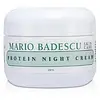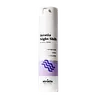What's inside
What's inside
 Key Ingredients
Key Ingredients

 Benefits
Benefits

 Concerns
Concerns

 Ingredients Side-by-side
Ingredients Side-by-side

Water
Skin ConditioningPetrolatum
EmollientOryza Sativa Bran Oil
EmollientGlycerin
HumectantEthylhexyl Palmitate
EmollientCetyl Alcohol
EmollientC10-30 Cholesterol/Lanosterol Esters
EmulsifyingCera Alba
EmollientDimethicone
EmollientOlus Oil
EmollientStearic Acid
CleansingPropylene Glycol
HumectantOligopeptide-5
Skin ConditioningRetinyl Palmitate
Skin ConditioningSoluble Collagen
HumectantZea Mays Oil
EmulsifyingSodium Borate
BufferingTriethanolamine
BufferingDiazolidinyl Urea
PreservativeSodium Benzoate
MaskingPropylparaben
PreservativeMethylparaben
PreservativeGlyceryl Acrylate/Acrylic Acid Copolymer
HumectantParfum
MaskingPhenoxyethanol
PreservativeTocopherol
AntioxidantHexyl Cinnamal
PerfumingWater, Petrolatum, Oryza Sativa Bran Oil, Glycerin, Ethylhexyl Palmitate, Cetyl Alcohol, C10-30 Cholesterol/Lanosterol Esters, Cera Alba, Dimethicone, Olus Oil, Stearic Acid, Propylene Glycol, Oligopeptide-5, Retinyl Palmitate, Soluble Collagen, Zea Mays Oil, Sodium Borate, Triethanolamine, Diazolidinyl Urea, Sodium Benzoate, Propylparaben, Methylparaben, Glyceryl Acrylate/Acrylic Acid Copolymer, Parfum, Phenoxyethanol, Tocopherol, Hexyl Cinnamal
Water
Skin ConditioningGlycerin
HumectantSqualane
EmollientSclerocarya Birrea Seed Oil
HumectantHydrogenated Polydecene
EmollientPolyglyceryl-3 Methylglucose Distearate
EmulsifyingPanthenol
Skin ConditioningGlyceryl Stearate
EmollientCetyl Alcohol
EmollientStearic Acid
CleansingDimethicone
EmollientHydrolyzed Centella Asiatica Extract
AntioxidantRetinol
Skin ConditioningAllantoin
Skin ConditioningCeramide NP
Skin ConditioningCeramide AP
Skin ConditioningCeramide EOP
Skin ConditioningPhytosphingosine
Skin ConditioningCholesterol
EmollientSodium Lauroyl Lactylate
EmulsifyingCarbomer
Emulsion StabilisingCopernicia Cerifera Cera
EmollientPropanediol
SolventSodium Cocoamphoacetate
CleansingHelianthus Annuus Seed Oil
EmollientTocopherol
AntioxidantXanthan Gum
EmulsifyingHumulus Lupulus Extract
AntimicrobialPropylene Glycol
HumectantDiazolidinyl Urea
PreservativeMethylparaben
PreservativePropylparaben
PreservativeWater, Glycerin, Squalane, Sclerocarya Birrea Seed Oil, Hydrogenated Polydecene, Polyglyceryl-3 Methylglucose Distearate, Panthenol, Glyceryl Stearate, Cetyl Alcohol, Stearic Acid, Dimethicone, Hydrolyzed Centella Asiatica Extract, Retinol, Allantoin, Ceramide NP, Ceramide AP, Ceramide EOP, Phytosphingosine, Cholesterol, Sodium Lauroyl Lactylate, Carbomer, Copernicia Cerifera Cera, Propanediol, Sodium Cocoamphoacetate, Helianthus Annuus Seed Oil, Tocopherol, Xanthan Gum, Humulus Lupulus Extract, Propylene Glycol, Diazolidinyl Urea, Methylparaben, Propylparaben
Ingredients Explained
These ingredients are found in both products.
Ingredients higher up in an ingredient list are typically present in a larger amount.
Cetyl Alcohol is a fatty alcohol. Fatty Alcohols are most often used as an emollient or to thicken a product.
Its main roles are:
Though it has "alcohol" in the name, it is not related to denatured alcohol or ethyl alcohol.
The FDA allows products labeled "alcohol-free" to have fatty alcohols.
Learn more about Cetyl AlcoholDiazolidinyl Urea is an antimicrobial preservative. It is commonly used to prevent bacterial, yeast, and mold growth.
Diazolidinyl Urea slowly breaks down into formaldehyde, an effective microbe killer but also a known allergen/carcinogen.
Some people who are allergic to imidazolidinyl urea also react to diazolidinyl urea. It ranked as the 14th most common allergen in patch tests from 2005–06.
Safety reviews show that at concentrations under 0.5%, the formaldehyde released remains below the accepted safety limit, making it considered safe for cosmetic use.
Ultimately, its safety depends on individual skin sensitivity and personal comfort with formaldehyde-releasing preservatives.
Learn more about Diazolidinyl UreaDimethicone is a type of synthetic silicone created from natural materials such as quartz.
What it does:
Dimethicone comes in different viscosities:
Depending on the viscosity, dimethicone has different properties.
Ingredients lists don't always show which type is used, so we recommend reaching out to the brand if you have questions about the viscosity.
This ingredient is unlikely to cause irritation because it does not get absorbed into skin. However, people with silicone allergies should be careful about using this ingredient.
Note: Dimethicone may contribute to pilling. This is because it is not oil or water soluble, so pilling may occur when layered with products. When mixed with heavy oils in a formula, the outcome is also quite greasy.
Learn more about DimethiconeGlycerin is already naturally found in your skin. It helps moisturize and protect your skin.
A study from 2016 found glycerin to be more effective as a humectant than AHAs and hyaluronic acid.
As a humectant, it helps the skin stay hydrated by pulling moisture to your skin. The low molecular weight of glycerin allows it to pull moisture into the deeper layers of your skin.
Hydrated skin improves your skin barrier; Your skin barrier helps protect against irritants and bacteria.
Glycerin has also been found to have antimicrobial and antiviral properties. Due to these properties, glycerin is often used in wound and burn treatments.
In cosmetics, glycerin is usually derived from plants such as soybean or palm. However, it can also be sourced from animals, such as tallow or animal fat.
This ingredient is organic, colorless, odorless, and non-toxic.
Glycerin is the name for this ingredient in American English. British English uses Glycerol/Glycerine.
Learn more about GlycerinMethylparaben is a preservative and is a paraben. It is used to prevent the growth of fungus, mold, and other harmful bacteria. Parabens are chemicals used as preservatives in both cosmetics and food.
Methylparaben can be synthetically created. It can also be found naturally in some fruits, such as blueberries.
Oftentimes, Methylparaben is combined with other parabens to help increase the shelf life.
The safety of Methylparaben is currently being studied. While ongoing studies are looking into the safety of parabens, the results have been very mixed. Some studies have not found Methylparaben to be harmful.
Learn more about MethylparabenPropylene Glycol is an odorless, colorless liquid. As a humectant, it helps skin retain moisture. It also aids in delivering active ingredients.
Another role of this ingredient is preventing a product from melting or freezing. Propylene glycol also adds antimicrobrial properties to a product, elongating product lifespan.
This ingredient is considered an organic alcohol and commonly added into both cosmetics and foods.
Those with sensitive skin or conditions may develop a rash when using this ingredient.
Learn more about Propylene GlycolPropylparaben is a preservative and is a paraben with antifungal and antimicrobial properties.
This ingredient can be naturally found in plants and insects, but most of it is synthetically manufactured for human use. In cosmetics, it is usually created by reacting para-aminobenzoic acid and propanol (an alcohol).
You can usually find this ingredient in water-based products.
Parabens have come under controversy due to the claim they are hormone disruptors. Studies show conflicting results. We recommend speaking with a professional if you have any concerns.
Propylparaben is commonly found in food, medicine, and cosmetics.
Learn more about PropylparabenStearic Acid is a fatty acid. It is an emollient, emulsifier, and texture enhancer.
As an emollient, stearic acid helps soften skin. It aids the skin's protective barrier by preventing water loss. It also provides a gentle cleansing effect without stripping away natural oils.
Stearic acid may also be used to enhance the texture of products. It can add volume and stabilize ingredients such as water and oil. This can help water and oil ingredients from separating.
Sources of stearic acid include animal or vegetable fats/oils such as coconut or shea. It can be naturally found in butter, cocoa butter, shea butter, vegetable fats, and animal tallow.
This ingredient may not be Malassezia folliculitis, or fungal-acne safe.
Learn more about Stearic AcidTocopherol (also known as Vitamin E) is a common antioxidant used to help protect the skin from free-radicals and strengthen the skin barrier. It's also fat soluble - this means our skin is great at absorbing it.
Vitamin E also helps keep your natural skin lipids healthy. Your lipid skin barrier naturally consists of lipids, ceramides, and fatty acids. Vitamin E offers extra protection for your skin’s lipid barrier, keeping your skin healthy and nourished.
Another benefit is a bit of UV protection. Vitamin E helps reduce the damage caused by UVB rays. (It should not replace your sunscreen). Combining it with Vitamin C can decrease sunburned cells and hyperpigmentation after UV exposure.
You might have noticed Vitamin E + C often paired together. This is because it is great at stabilizing Vitamin C. Using the two together helps increase the effectiveness of both ingredients.
There are often claims that Vitamin E can reduce/prevent scarring, but these claims haven't been confirmed by scientific research.
Learn more about TocopherolWater. It's the most common cosmetic ingredient of all. You'll usually see it at the top of ingredient lists, meaning that it makes up the largest part of the product.
So why is it so popular? Water most often acts as a solvent - this means that it helps dissolve other ingredients into the formulation.
You'll also recognize water as that liquid we all need to stay alive. If you see this, drink a glass of water. Stay hydrated!
Learn more about Water